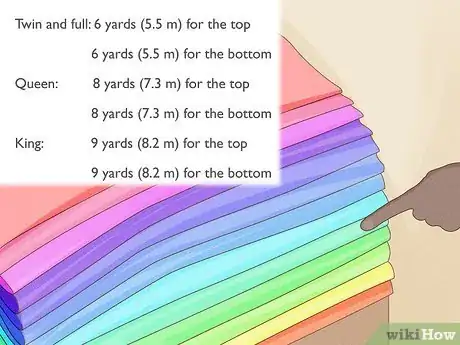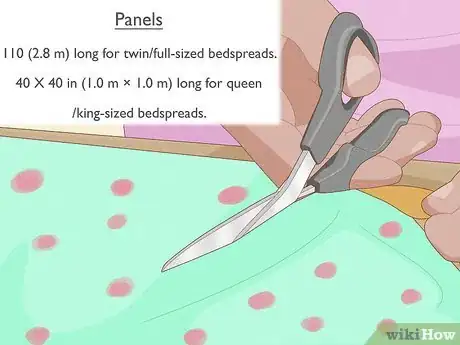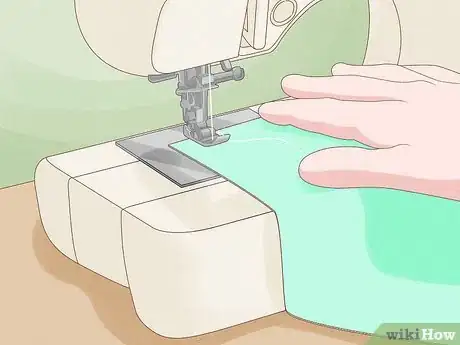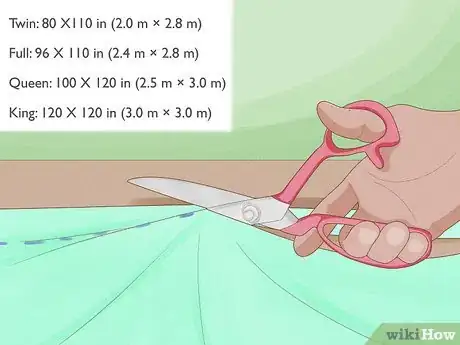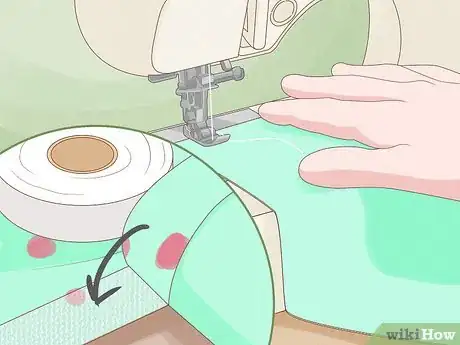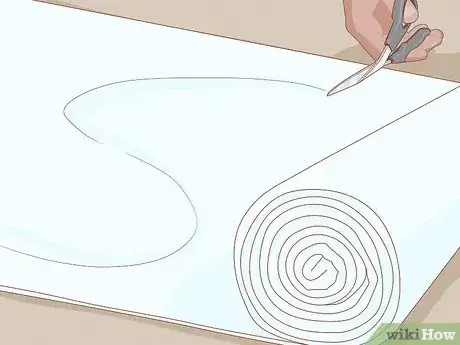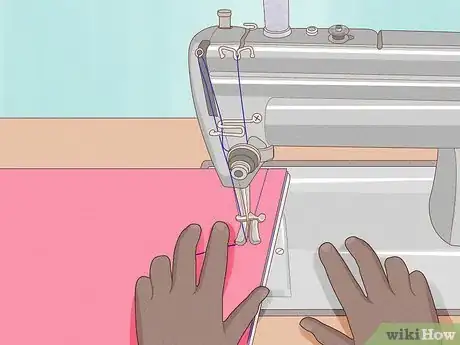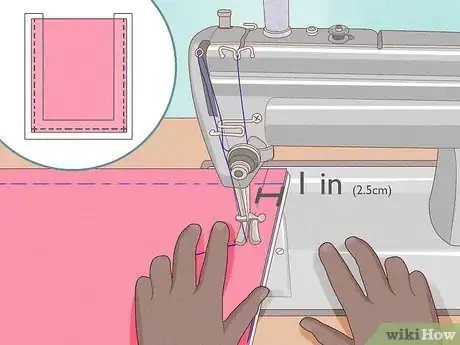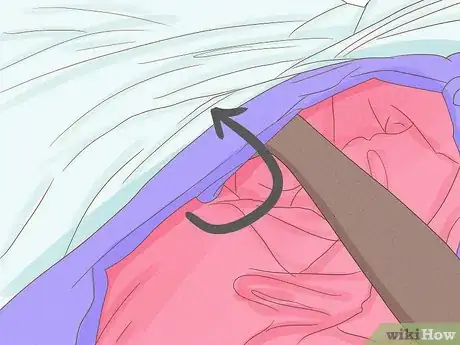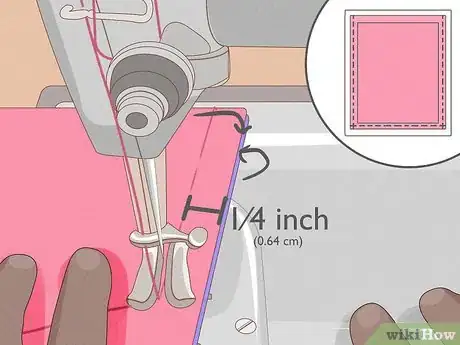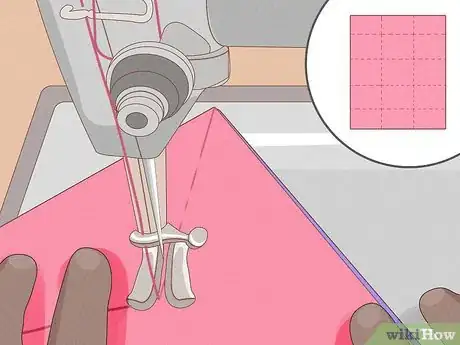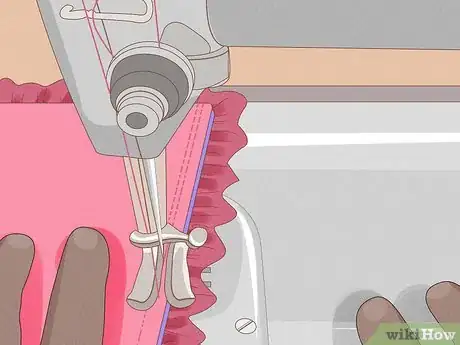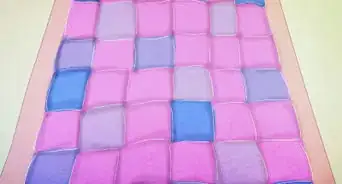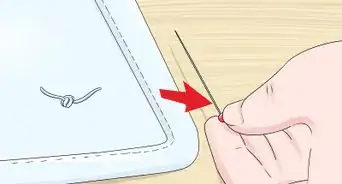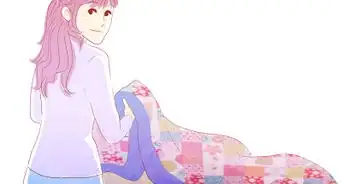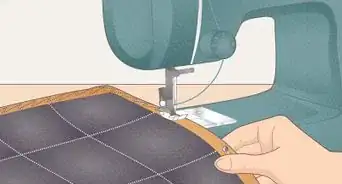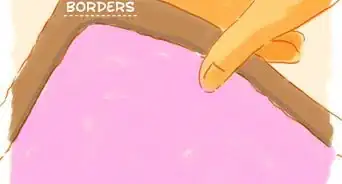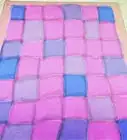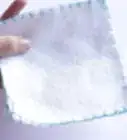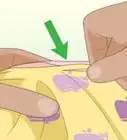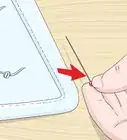This article was co-authored by wikiHow staff writer, Jessica Gibson. Jessica Gibson is a Writer and Editor who's been with wikiHow since 2014. After completing a year of art studies at the Emily Carr University in Vancouver, she graduated from Columbia College with a BA in History. Jessica also completed an MA in History from The University of Oregon in 2013.
There are 13 references cited in this article, which can be found at the bottom of the page.
wikiHow marks an article as reader-approved once it receives enough positive feedback. In this case, 81% of readers who voted found the article helpful, earning it our reader-approved status.
This article has been viewed 198,511 times.
Learn more...
If you're tired of searching for a bedspread that matches your style, sew your own unique spread. Bedspreads are great projects for sewers with a little experience since you can truly customize the look. All you need is fabric, batting, a sewing machine, and about an hour to create a hand-sewn bedspread.
Steps
Cutting the Materials
-
1Buy stylish fabric to fit the measurements of your bed. Although you can find narrower bolts, choose a comfortable fabric that's at least 54 in (140 cm) wide regardless of the bedspread size. For an easy spread, buy 2 sets of flat sheets that fit your bed. Choose a fabric that you can machine wash and dry. Cotton, wool, or acrylic blends are all popular fabrics for bedspreads and they wear well. To use fabric from the bolt, buy:[1]
- Twin and full: 6 yards (5.5 m) for the top and 6 yards (5.5 m) for the bottom
- Queen: 8 yards (7.3 m) for the top and 8 yards (7.3 m) for the bottom
- King: 9 yards (8.2 m) for the top and 9 yards (8.2 m) for the bottom
-
2Cut 2 or 3 panels of fabric for each side of the bedspread. Since your fabric bolt is 54 inches (140 cm) wide, sew 2 panels together for each side of a twin or full-size bedspread. For a queen or king, use 3 horizontal panels for each side.[2]
- Cut the panels 110 inches (2.8 m) long for twin or full-sized bedspreads.
- Make each panel 40 by 40 inches (1.0 m × 1.0 m) long for queen or king-sized bedspreads.
Advertisement -
3Line up the panels and use fusible bonding tape to iron them together. If you're making a twin or full-sized spread, place 2 of the long panels next to each other pattern-side up so the panels line up. For a queen or twin-sized spread, lay 3 of the panels together pattern-side up so the long sides touch. Then, lay a strip of fusible bonding tape along 1 side of each panel where it touches the other panel. Overlap the other panel and iron it so they fuse together.[3]
- If you don't want raw edges showing, tuck the side of the top panel under by 1⁄4 inch (0.64 cm) before you iron it onto the other panel.
- If you're using fabric with a pattern, line up the pattern before you join the panels.
-
4Sew the top fabric panels together. Take the panel pieces to your sewing machine and arrange them so the pattern faces down. Zigzag stitch down the side of the panels where you fused them with the bonding tape. Repeat this for the other panel if you're making a queen or king-sized bedspread.[4]
- Use thread that matches the color of your fabric so it doesn't stand out.
- If you're using thick fabric, trim the excess fabric 1⁄4 inch (0.64 cm) from the seam so your bedspread isn't bulky.
-
5Cut the fabric piece to fit the size of your bed. Spread the assembled fabric flat and get out fabric chalk and a yardstick. Mark the dimensions on the fabric and use scissors to cut out the top fabric piece. Cut the piece:[5]
- Twin: 80 by 110 inches (2.0 m × 2.8 m)
- Full: 96 by 110 inches (2.4 m × 2.8 m)
- Queen: 100 by 120 inches (2.5 m × 3.0 m)
- King: 120 by 120 inches (3.0 m × 3.0 m)
-
6Sew the bottom panels together to make the underside of the bedspread. Set aside the top piece while you repeat the steps using the fabric that you chose for the bottom of the bedspread. Arrange 2 or 3 panel pieces pattern-side up and fuse them together. Then, make straight stitches down the sides of the panels to join them as you did for the top fabric piece.[6]
- Once you've finished preparing the top and bottom fabric pieces, you'll just need to get out enough batting for filling the comforter.
-
7Unroll quilt batting and cut it to the same size as the bedspread. Buy a package of quilt batting according to your bed size and unroll it on your work surface. Spread 1 of your bedspread fabric pieces on the batting and cut the excess batting from the sides so the batting is the same size as the fabric. For a warmer blanket, use more than 1 layer of batting.[7]
- You can buy batting made from cotton, polyester, or bamboo, for instance. Cotton and bamboo are great natural choices, while polyester is easy to find and inexpensive. Wool batting is a good choice if you want a very warm bedspread.
- Keep in mind that more layers are more likely to shift around so it's important to sew over the blanket to keep the batting in place.
Sewing a Basic Bedspread
-
1Stack the batting on the 2 fabric pieces and pin the sides in place. Lay the batting piece flat on your work surface and put the top bedspread piece directly on it with the pattern facing up. Line up the sides with the batting. Then, place the bottom bedspread piece on top so the pattern faces down and line up the sides. Insert sewing pins along the edges of the bedspread so the pins go through all 3 layers.[8]
- Put the sewing pins about every 2 inches (5.1 cm) along the sides.
-
2Sew straight stitches around 3 sides of the bedspread. Take the bedspread to the sewing machine and sew 1 inch (2.5 cm) from the raw edge. Make straight stitches down the long side, 1 short end, and up the other long side.[9]
- It's important to leave 1 of the short ends open so you can turn the bedspread right-side out.
-
3Turn the bedspread right-side out and pin the raw edge closed. Reach into the bedspread and grab hold of the fabric. Flip it out so the batting is in the middle and the fashion fabric encloses it. Then, smooth out the bedspread so the batting is even and tuck the raw edges under by 1 inch (2.5 cm). Insert sewing pins every 2 inches (5.1 cm) along the last side.[10]
- Before you pin the edge of the spread, push into the corners with your fingers or a knitting needle to give them sharp definition.
-
4Top stitch around the entire bedspread so the edges lay flat. Start sewing along the unfinished edge that you just pinned and make straight stitches that are 1⁄4 inch (0.64 cm) away from the edge. Keep topstitching around the other sides that you already finished and keep close to the edge to stabilize it.[11]
- Remember to remove sewing pins as you work so you don't damage your sewing machine.
-
5Stitch across the bedspread if you want to secure the batting. Batting can clump a little after you wash and dry the bedspread a few times. To keep it in place, straight stitch across the bedspread in any design you like. To make a simple grid, sew 3 or 4 straight lines across the length of the bedspread. Leave an equal amount of space between each line. Then, make 5 or 6 straight lines across the short side of the spread with equal space between them.[12]
- If you'd like the topstitching to stand out instead of blend in, use a different color of thread. For example, if you have a cream-colored bedspread, use burgundy or cornflower blue thread that compliments the fabric.
-
6Attach a ruffle to the ends and sides of your bedspread for a frilled look. Buy a dust ruffle that fits your bed and cut away the flat smooth part that covers the top of the bed. Lay the assembled bedspread so the back faces up and line up the raw edges of the ruffle with the sides of the spread so the ruffles extend out. Then, use a zigzag stitch to sew the ruffle to the sides of the bedspread.[13]
- You could also make your own ruffled strips so they're as long as you like.
-
7Cut a slit in each corner to make a fitted split corner bedspread. Bedspreads usually shift around a little, but if you want yours to stay in place, make it hug the corners of your bed. Lay your assembled bedspread on the bed so the sides fall evenly and cut a diagonal line from a bottom corner up to the top of the mattress. Then, tuck the raw edges under by 1⁄4 inch (0.64 cm) and hem them before repeating this for each corner of the spread.[14]
- If you don't want to eyeball the cutting, trace the line with fabric chalk so you have a guideline.
Community Q&A
-
QuestionI want to cut the corners of the bottom of a bedspread to fit a 4-poster bed. How do I measure?
 Community AnswerYou have two options: One, do nothing and just tuck the corners of the comforter in and do not allow it to drape over/around the columns. Two, you could measure the length and width of your mattress, then cut out the square corners so that the comforter is in the shape of a cross.
Community AnswerYou have two options: One, do nothing and just tuck the corners of the comforter in and do not allow it to drape over/around the columns. Two, you could measure the length and width of your mattress, then cut out the square corners so that the comforter is in the shape of a cross. -
QuestionHow do I make a queen bedspread that looks like a beach scene, water, sand, and sky?
 Community AnswerGet a beach-designed blanket and a few blue, tan and blue with white cloud pillows, and a few plush sea animals and shells.
Community AnswerGet a beach-designed blanket and a few blue, tan and blue with white cloud pillows, and a few plush sea animals and shells. -
QuestionHow do you make the squares on a comforter?
 Community AnswerThis is the same concept as a quilt. To get the desired amount of squares, you need to figure out your fabric as well as how to attach the patterns together. Then you can sew your quilt fabric using the comforter pattern in the tutorial.
Community AnswerThis is the same concept as a quilt. To get the desired amount of squares, you need to figure out your fabric as well as how to attach the patterns together. Then you can sew your quilt fabric using the comforter pattern in the tutorial.
Things You'll Need
- Fabric
- Fusible bonding tape
- Quilt batting
- Scissors
- Ruler
- Sewing machine
- Sewing pins
- Iron and ironing board
References
- ↑ https://youtu.be/cy9QFB6CXEc?t=36
- ↑ https://sewguide.com/bed-linen-sizes/
- ↑ https://youtu.be/qBNYc59g4S4?t=189
- ↑ https://youtu.be/qBNYc59g4S4?t=236
- ↑ https://sewguide.com/bed-linen-sizes/
- ↑ https://youtu.be/qBNYc59g4S4?t=313
- ↑ https://youtu.be/6UMO5UWqm-U?t=30
- ↑ https://youtu.be/6UMO5UWqm-U?t=56
- ↑ https://youtu.be/6UMO5UWqm-U?t=77
